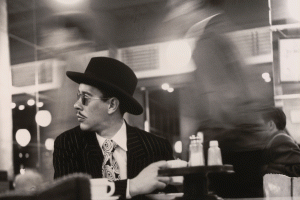
That’s how New York Times reviewer Oliver Prescott described Betty Smith’s A Tree Grows in Brooklyn.

As we discussed yesterday in class, one of the factors contributing to New York’s mid-twentieth-century renaissance were the massive construction projects that transformed the city’s landscape. These projects, which began in the LaGuardia years and continued during the mayoralty of Kenneth O’Dwyer, brought in huge sums of federal and state money for the development of highways, bridges, tunnels, and housing projects. Although it was financed mainly by UN funds, the construction of the United Nations complex on New York’s east side (1947-1952), in many respects epitomized these developments.

In A Walker in the City, Alfred Kazin describes the “uncanny” experience of seeing new public housing projects planted amid the tenements he knew growing up.
Despite those fresh diagonal walks , with their trees and children’s sandboxes and Negro faces calmly at home with the white, so many of the old tenements have been left undisturbed on every side of the project, the streets beyond are so obviously just as they were when I grew up in them, that it is as if they had been ripped out of their original pattern and then pasted back in again behind the unbelievable miniatures of the future.
The photograph above, from the New York City Housing Authority archives (an invaluable resource!), gives an idea of what Kazin was thinking about.

As with his closely related remarks about bop or, in “Harlem is Nowhwere,” about apparently growing signs of crime and disorder in Harlem, those comments show Ellison grappling with some features of African-American life that seemed to him and to many of his contempories new and portentous–and, importantly, not to fit neatly into any of the ideological frameworks they had available.

Ellison was not an admirer of bebop. A trained musician himself, Ellison had grown up in Oklahoma where he’d become a great admirer of the “territory” bands–the traveling jazz groups that laid much of the foundation for swing. During the 30s and early 40s when he was living in Harlem, Ellison enjoyed the musical renaissance of big band, “hot” jazz and is said to have attended the Savoy Ballroom, where Chick Webb held forth and all the great African-American bands of the era appeared, two or three times a week. He became a friend and champion of musicians in Count Basie’s band.
So, when bop appeared on the scene, unsurprisingly it was not to his taste

What kind of architect is Guy Haines? “What’s known as modern,” he says to Bruno when they first meet? (23) And other comments suggest that Guy is part of the movement of modernist architects that would do much to remake the American metropolis in the decades after World War II.

The U.S. has produced many a weird, misanthropic writer. But Patricia Highsmith, who happens to have shared a birthday with Edgar Allan Poe, belongs high on anyone’s list of the strange and disturbing. As Terry Castle writes in the superb essay pasted in below, Highsmith once commented that creepy ideas came to her as “frequently as a rat has orgasms.”
In other words, I suppose, often.